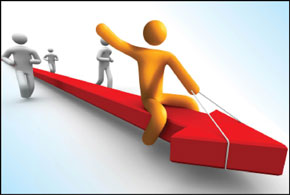By John Goodman
Customer experience is a top priority for 86 percent of executives, according to Gartner’s “Amplifying the Enterprise: The CIO Agenda” report. Technology can enhance many aspects of customer experience, but most companies are missing the biggest opportunity—anticipation and proactive service.
Although Amazon has received a lot of attention for its proposal regarding drone delivery, its basic strategy has always been one of anticipation and prevention. Amazon knew that once a book was ordered, the next question would be, “When will I receive it?” Therefore, the company proactively sent an email stating: “You will receive your order on Tuesday,” which eliminated a phone call and impressed customers with Amazon’s service.
I refer to this proactive action as “psychic pizza”: Your doorbell rings, and the pizza you were about to order is delivered. By being proactive, a company can eliminate the cost of the service call while dazzling the customer with great service. The biggest payoffs of proactivity often come not from customer service but from marketing—more effectively setting customer expectations and providing information.
Two recent studies by the American Society for Quality highlight the opportunity. First, a 2012 survey of 600 U.S. companies, found that businesses believe the single biggest quality issue is setting proper customer expectations. A second ASQ survey of more than 2,000 companies in 22 countries, “Global State of Quality: Discoveries 2013,” reported that the quality function does not have the tools needed to effectively identify opportunities for anticipation and to quantify the pay-off of corporate quality initiatives.
The 2013 global study suggests that executives who are responsible for quality are concerned about the close alignment of product and service quality with customer relationships—a concept ASQ terms “Qustomer.” But it is clear that organizations have not yet dealt with the implications of an end-to-end customer experience or discovered how technology can help achieve the best experience for customers.
Also, the marketing and finance departments are not noted as users of quality data or revenue growth. They are not fostering positive word of mouth to win new customers.
If there isn’t a bottom-line payoff, no one will want to invest in customer experience initiatives. However, technology managers can provide the tools and data needed to address both these issues.
The technology, service, marketing and quality departments can partner to enhance the customer experience and the bottom line in several ways: Set proper customer expectations via welcome messages; provide just-in-time education and warning of problems; confirm imminent service delivery; and help service and quality functions gather voice-of-the-customer information to make a business case for an enhanced experience. Following are some examples.
Setting Customer Expectations
Technology can set expectations via emails, videos, new user portals and Websites. Up to 30 percent of all customer dissatisfaction is caused by customers making simple mistakes or having incorrect expectations.
Technology can deliver welcome packages that highlight the top five things customers need to know, as well as problems to avoid. The welcome message can be a mashup of video, graphics and bulleted text. Technology can also tailor the welcome package to the customer’s level of technical knowledge. For example, it could ask, Are you a novice, somewhat technical or a technology expert?
· Zipcar provides short videos on basic transactions, such as extending the rental for two more hours. The videos, though only 90 seconds, are fun and entertaining, as well as educational.
· At the beginning of an online form, an insurance company highlighted “the top five mistakes made when filling out this form.” As a result, the number of mistakes declined precipitously.
· ServiceMaster’s American Home Shield maintenance unit sent an email to customers with hot-water repair orders, warning them that they might not have hot water for two days. Customer satisfaction went up 20 points as a result of the clear communication.
Providing Education and Early Warning
The technology department can partner with the service group to provide just-in-time education on how to get more from complex product functions. Further, the company’s operational databases can highlight and communicate process failures and impending unpleasant surprises. Customers appreciate the warning, since it allows them to avoid—or at least prepare for—the problem.
· Auto companies can learn, via wireless links to the car, which functions of the entertainment and navigation systems are not being used. They can then push a short video on how to use the functionality. Using more functions creates higher perceived product value.
· Southern California Edison, using smart meter data, identified 30,000 customers whose bills were on track to be significantly higher than expected. Ten days into the billing cycle, the system sent an email with the header, “Your bill is going to be higher than you expect and we’re concerned.” More than 50 percent of customers opened the email. Compared to a control group, satisfaction rose by double digits, energy usage fell and customer calls decreased.









